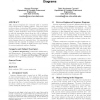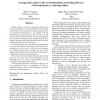90 search results - page 2 / 18 » Reverse Engineering of the Interaction Diagrams from C Cod... |
ICSE
2005
IEEE-ACM
14 years 8 months ago
2005
IEEE-ACM
UML sequence diagrams are commonly used to represent object interactions in software systems. This work considers the problem of extracting UML sequence diagrams from existing cod...
WCRE
2010
IEEE
13 years 6 months ago
2010
IEEE
—We present a semi-automated approach for the reverse engineering of UML sequence diagrams. Our approach starts with a set of execution traces that are automatically aligned in o...
SAC
2004
ACM
14 years 1 months ago
2004
ACM
Web applications have become complex and crucial for many firms, especially when combined with areas such as CRM (Customer Relationship Management) and BPR (Business Process Reen...
ICSM
2000
IEEE
14 years 28 days ago
2000
IEEE
Several reverse engineering methods for recovering objects from legacy systems have been proposed in the literature, but most of them neglect to identify the relationships among t...
ISESE
2005
IEEE
14 years 2 months ago
2005
IEEE
During software evolution, programmers spend a lot of time and effort in the comprehension of the internal code structure. Such an activity is often required because the available...


